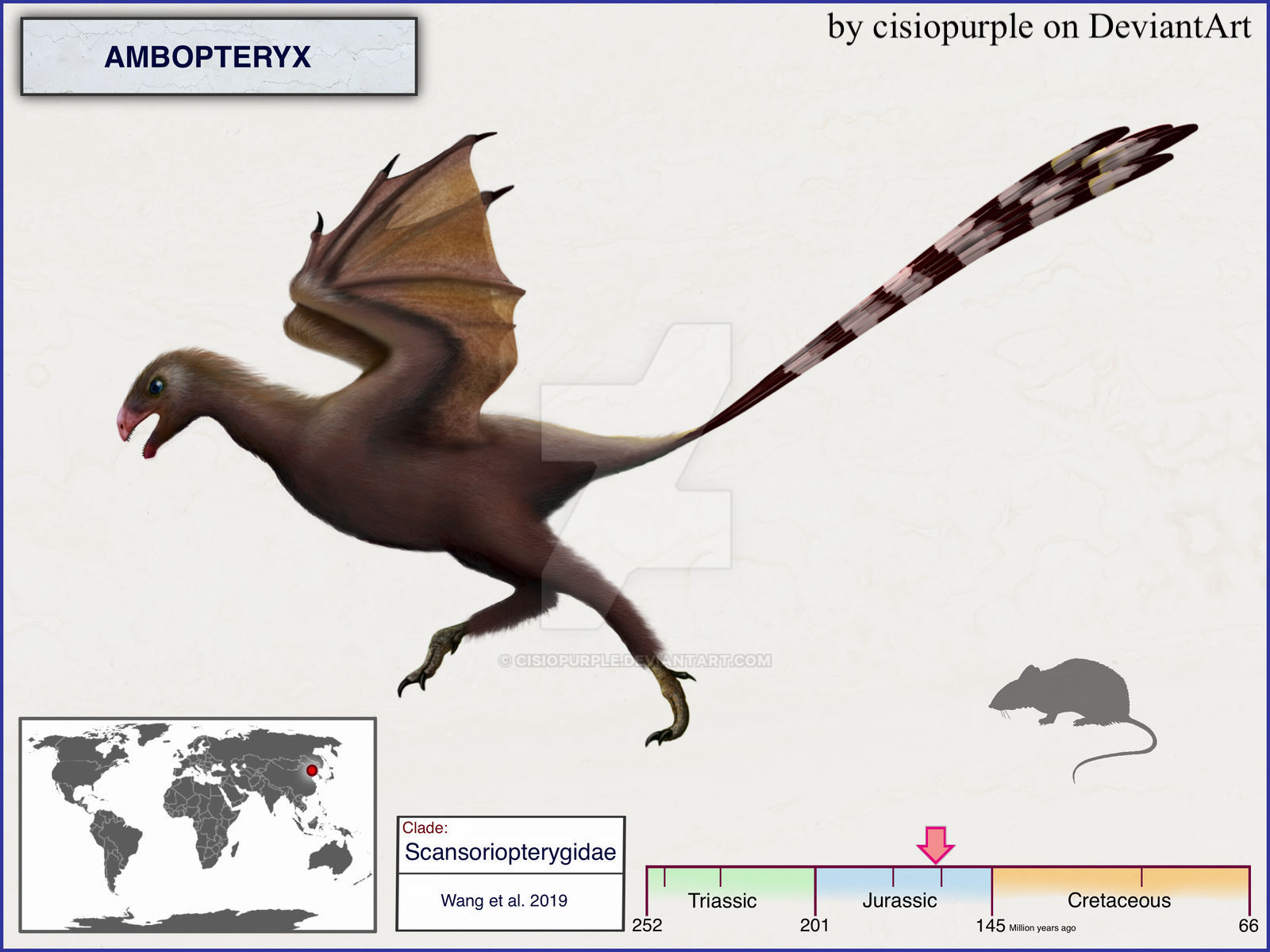Welcome to Ambopteryx

Name Definition
Both wing
Name Given By
Min Wang, Jingmai O’Connor, Xing Xu, and Zhonghe Zhou in 2019
Location
Haifanggou Formation of in Liaoning, China
Classification
Dinosauria, Saurischia, Theropoda, Scansoriopterygidae
Size
approximately 26 cm tall (10.2 inches), about 32 cm (13 inches), about 306 grams (0.675 lbs)
Temporal Range
Oxfordian of the Late Jurassic, ~163 million years ago
Ecological niche
small omnivore
Species/Sub Species
A. longibrachium
Diet
given there have been a few gastroliths and bone fragments in the abdominal region of Ambopteryx, along with their unusual dentition, it could suggest that Ambopteryx was omnivorous
Introduction
Ambopteryx is a genus of scansoriopterygid theropods that lived in China during the Late Jurassic. Ambopteryx derives from the Latin word ambo which means “both” and the Greek word pteryx which means “wing” which is in reference to its membranous wings (similar to pterosaurs) and its bird-like body. The specific name longibrachium derives from the Latin word longus which means long and brachium from Greek means “upper arm” or “forelimb”. This is in reference to its relatively long arms to support its wing membranes.
Ambopteryx is the second dinosaur to be found with a membranous wing, the first being Yi qi. Yi qi was described in 2015 and was made Ambopteryx’s sister taxon. The holotype of Ambopteryx is thought to be either a sub-adult or an adult and consists of virtually complete and articulated skeleton with some soft tissue fossilized on a slab (this means that the soft tissue was compressed into the rock that was the slab) and a counter slab (the other half of the compression fossil). The holotype was discovered in 2017 from the Haifanggou Formation near Wubaiding Village in Liaoning and belongs to the Yanliao Biota. The wing membrane was preserved as a brownish layer with the matrix surrounding the left hand, right forelimb, and the abdomen. While its wings are featherless, however, the head, neck and shoulders were discovered to possess dense layers of feathers.
Similar to its scansoriopterygid relatives, Ambopteryx had a short and rounded head, and a long third finger compared to its other manual digits. It was initially thought that scansoriopterygids like Ambopteryx used their elongated third finger to pick out grubs and other small insects, comparable to the modern day aye-aye (Daubentonia madagascariensis). However, when Wang and colleagues described Ambopteryx, they suggested that the third finger was mainly used for the attachment of the patagium (wing membrane) since their fingers were probably surrounded by the patagium and would have a limited range of motion. Ambopteryx was probably most closely related to Yi qi among all the scansoriopterygids and shared with Ambopteryx a styliform, an elongate bone that extends from the distal (away from the center of the body) end of the ulna, one of the two large bones in the forearm, the other one being the radius. The styliform is slightly curved and tapered towards its distal end. The styliform also supported the patagium along with the rest of the fingers. The forelimbs were about 1.3 times longer than the hindlimbs, with the ulna being almost twice the width of the radius. Contrary to most non-avian theropods, Ambopteryx’s tail ended in a pygostyle, a triangular plate in the tail formed by caudal vertebrae which usually supports tail feathers, but is common in birds. The only other non-avian theropods that have a pygostyle are oviraptorosaurs and therizinosaurs.
The abdominal region of Ambopteryx has been noted to carry a few gastroliths (rocks that usually herbivorous dinosaurs eat swallow to help aid in breaking down the food for digestion) which would suggest a herbivorous diet, but there are also large fragments of what seems to be animal bones which represents the stomach contents. Although the diets of scansoriopterygids were previously unknown, but their unusual dentition combined with the gastroliths and possible animal bones in the stomach indicate that Ambopteryx was probably omnivorous as well as the rest of the scansoriopterygids.